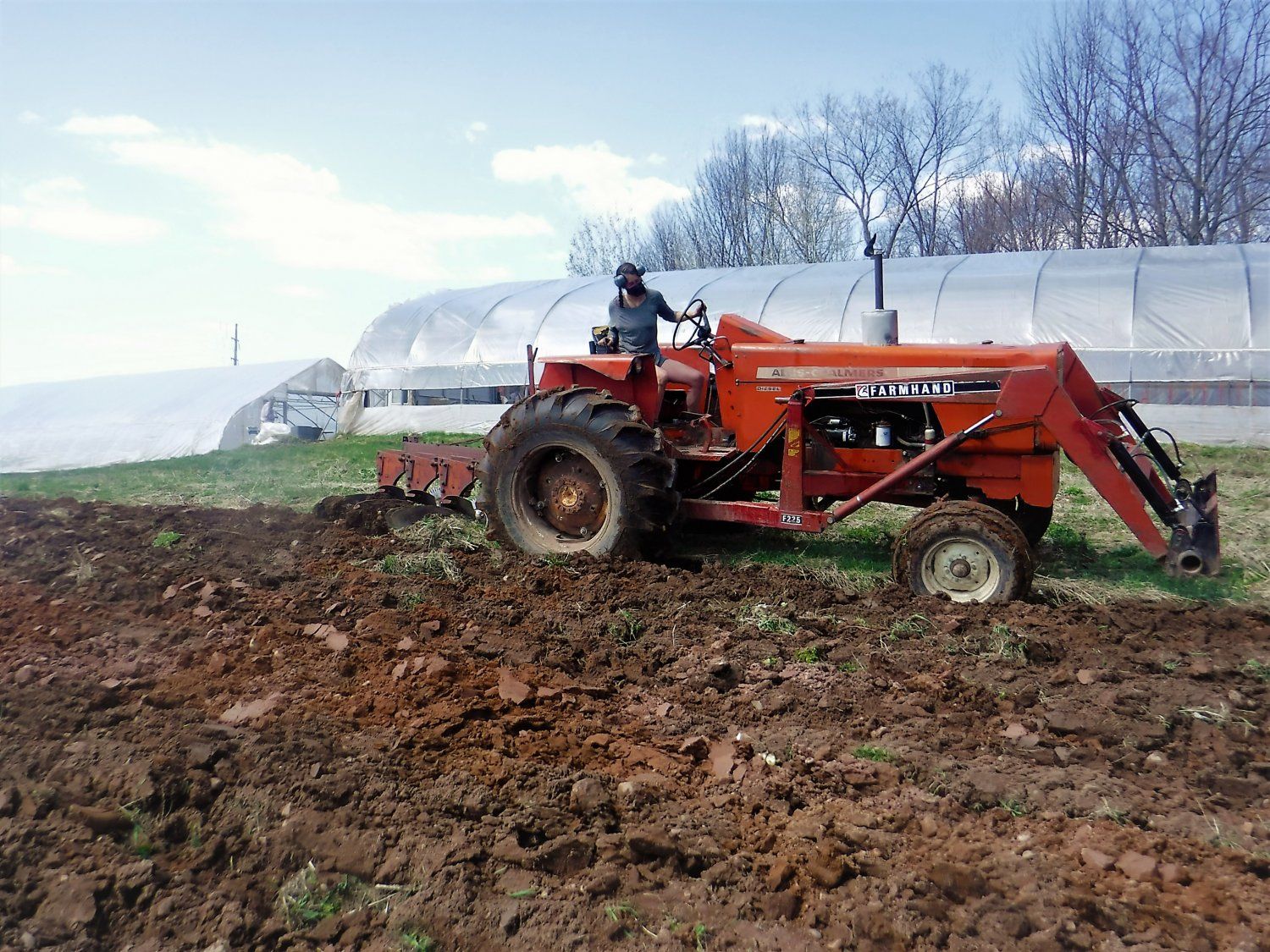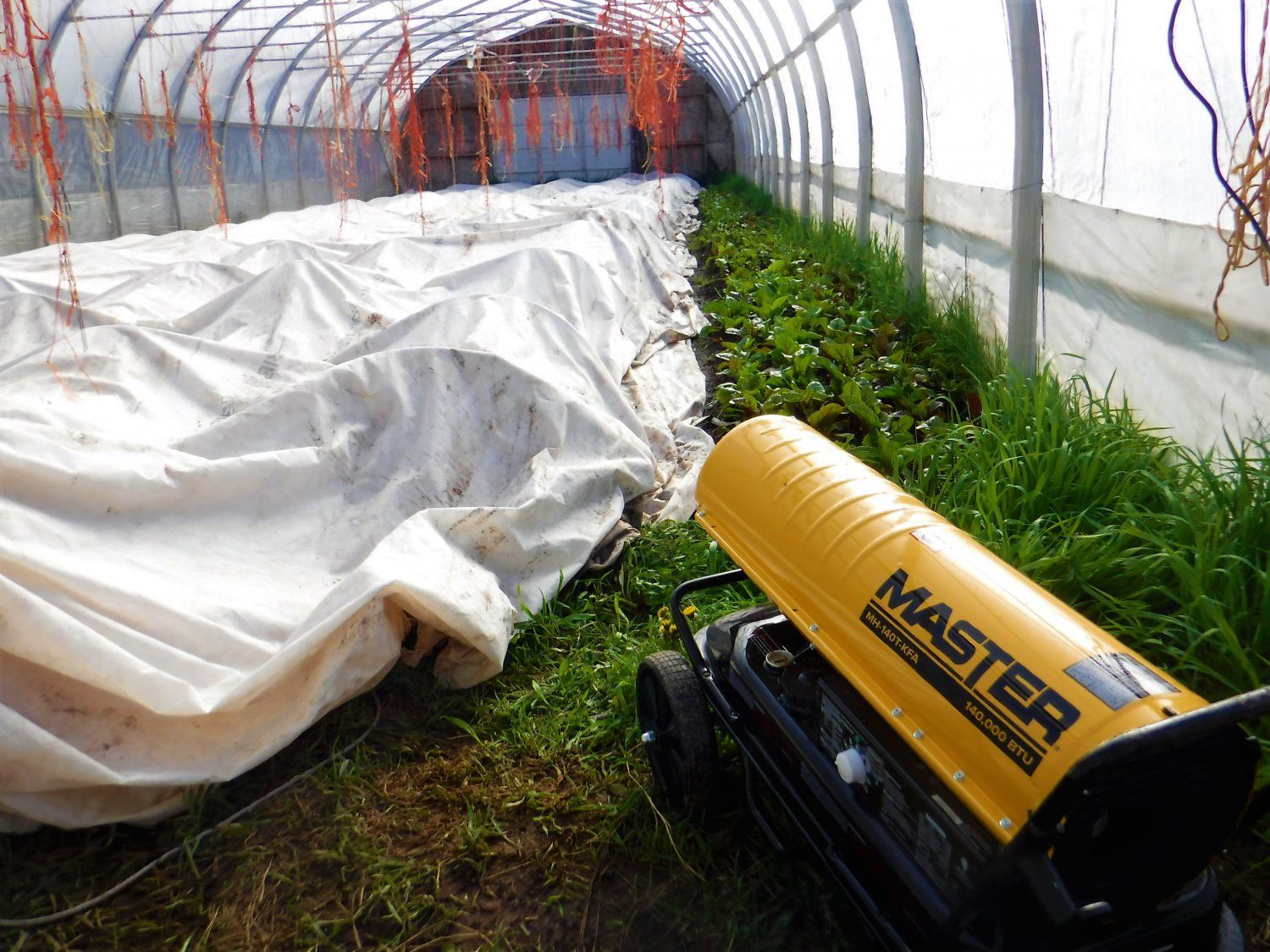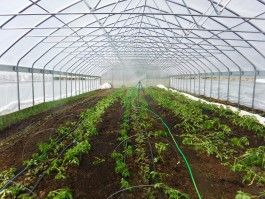Greetings from your farmers at Great Oak Farm! It's been another productive week, but I tell you I am officially ready for a break from this 35 degrees and raining weather... uffda. Looking forward to this Saturday to give us a little taste of summer sunshine.
Before we get into what's been happening on the farm, I want to let you know we've got some great new box options for Mother's Day (coming up on Sunday May 9)!
Now that tomatoes and cucumbers are planted out in the hoophouses, we watch the weather obsessively. If it gets too cold, we could lose them all, so failure is not an option. Every evening after dinner, my kids and I head back out to our hoophouses to cover the crops back up with 2-3 layers of white floating row cover. This keeps the heat of the ground close by the tender plants, and provides about 5-10 degrees of frost protection. If it's going to be much colder than freezing, or the temps are forecasted to hover at freezing for most of the night, I head back out at about 10 pm and fire up some portable heaters for some extra insurance. Below is a picture of the same tomato house shown above, this time all tucked in for bed. As soon as temps are warm enough, we'll begin trellising the tomato and cucumber vines up to better manage them, but for now they stay low so we can keep them warm under cover at night.

Then, every morning, we peel back the row covers once the temps are back above 40 in the hoophouses to maintain good air circulation and prevent disease problems from arising. If the sun comes out, it's back to the hoophouses to open doors and roll up the sides to keep the houses from overheating and cooking our tender plants. What happens if the sun goes behind the clouds and cool rain picks up again? You guessed it - we drop what we're doing and head back out to close them up again.
Farming is always a dance with the weather, and growing in hoophouses doesn't let us off the hook. Needless to say, we have been getting our steps in each day managing those tender but oh-so-delicious cukes and tomato plants! Here's what our baby cukes are looking like now. If all goes well, we should be picking the first cukes about 6 weeks from now (and that weedy mess along the outside of the hoophouse on the upper left side of the picture will be outta there by the time you read this!)
In order to keep up with all of the workload, we've welcomed Farmer Sean back on the crew full time now. He was here 2 years ago, and worked at the Red Cliff Tribal Garden last year. He's a geologist by training, so whenever we find cool rocks in the field we run them past Sean to get the scoop. Here he is transplanting peppers into one of our hoophouses this week. He's an accomplished musician as well, and it's great to welcome him here for another season at Great Oak Farm!
In addition to all the transplanting this past week, I was able to get a little more field work done before the rains made everything too muddy. The big highlight was getting 3.5 acres of sod plowed up to expand our vegetable production a little more. Before we can grow more veggies there however, we have to improve the soil. We'll be over that field many times in the next month or two with the tractor and a whole suite of tools to get the weeds out. Once the weeds are cleaned up we'll be seeding it with cover crops to help build soil organic matter levels, continue to outcompete weeds, and fix nitrogen from the air into the soil to feed the 2022 crop of veggies that we'll grow there.
Speaking of cover crops, the picture above shows our old field tractor plowing up the field that will be home to all of our broccoli, cabbage, cauliflower, and brussels sprouts in a few more weeks. Last summer, this field grew a robust stand of cover crop called Austrian winter peas. The peas have bacteria on their roots that fix nitrogen from the air into the soil to build additional fertility, and died with the onset of winter. They left behind a thick mulch of pea straw, which protects the soil from erosion and helps smother spring weeds. I know it might not look sexy or technologically new-fangled, but this is what sustainable soil management looks like. Keeping soil covered when possible with living or dead mulch helps keep biological systems humming. Happy soil means happy transplants, and happy plants means bountiful harvests.
Adding more ground for cover crop production has been a long term goal of mine for many years. Ideally, we would have an equal amount of fields used for veggie production and fields planted to cover crops to build soil health. With the additional 3.5 acres of new ground coming into production, we'll be at 14 acres of veggies and 10 acres of cover crops this year, so we're getting closer!
_LI.jpg)
Thank goodness for reliable tractors - that's a lot of ground to cover for the 4 of us Great Oak farmers. Most of the time it's pretty easy to find new or used parts for our old tractors when something wears out, but as you can see in the picture above we've had to improvise from time to time. The adjustable linkage on the rear left of our field tractor stripped out last year, and we've had a heck of a time finding a replacement. We've tried a few replacement parts over the last few months, but none have been the right size. Keeping it chained in place might become a permanent fix, but that's fine - we're not out to win any tractor shows around here. As long as it gets the job done, we'll take a hard working tractor in it's "work clothes" any day.
But we can't just stop once the tractors are maintained - we need to keep up on the tools they pull as well. This week I tore down, adjusted, recalibrated, and regreased the old Stanhay seeders we use for planting carrots and beets. While it's tedious and I'd rather just get out and plant, keeping up on the equipment before the season begins helps to ensure a smooth growing season. Making sure everything works correctly and is ready to roll when we need it is pretty critical to success. Sometimes we have a narrow window of opportunity to get a job done between rainy days, so being prepared with equipment we can count on makes all the difference.
One last bit of news for the week: we pulled the disc we used to pull with the horses out of the scrap pile, and sent it home with Farmer Ryan to use at his own farm, Throughdirt Farm. This little baby is nothin' but work clothes, but it can still get the job done. He will be pulling it with an old Farmall M tractor and using it to prepare beds for veggie production. I spent a lot of hours dragging this little disc around while staring at the backsides of our big Belgian draft mares Shayla and Bess, and it makes me so happy to see it get another round of use somewhere else.
The current disc that we drag behind the tractor is 8' wide with 2 gangs of cutters (the disc above is 4' wide with one gang of cutters). Just to illustrate the difference between draft horse and tractor power, it would take at least 8 draft horses to pull the big disc we use now! PLUS, when we use the big disc now we also hook up a second drag directly behind the disc to get additional tillage done all in one pass. It would take 2-3 additional horses to pull the drag. That's a lot of live power to manage, and a lot of mouths to feed. Aside from a few very special circumstances (outside of Amish communities), the days where horsedrawn farmers can make a living are long past, but I still deeply admire and appreciate the women and men who work with those gentle giants and keep the art of animal powered agriculture alive.
Well, that's it from the farm this week. Thanks as always for your support of local farms and food producers, and happy Spring!
In community,
Farmer Chris
Great Oak Farm


.JPG)
.JPG)
.JPG)
.JPG)
.JPG)
.JPG)



